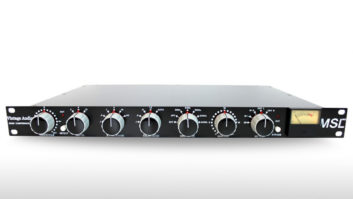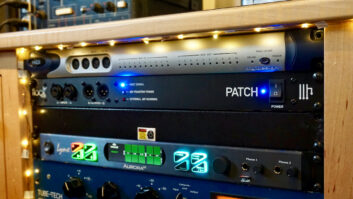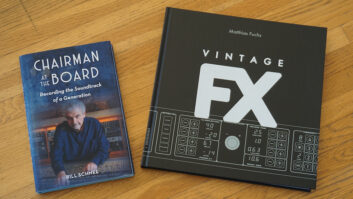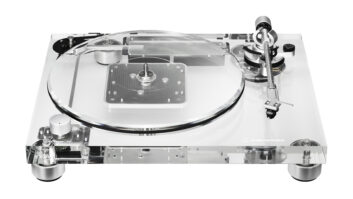The holiday season is once again upon us, and I have a few hints as to what may be the perfect gift for your favorite engineer or producer—or even yourself!

Blue Satellite Headphones
Nothing suits an on-the-go engineer or producer better than a nice pair of headphones and the new Blue Satellite ($299) is an excellent option. Blue is still a newcomer to the headphone market but the style, comfort and sound quality of its phones has garnered respect both inside and outside the music community. The Satellite is Blue’s latest offering and the first to include wireless functionality and noise-canceling features—and, I must say, they’ve done it right.
The Satellite, which is substantially less cumbersome than previous Blue models, is truly built for portability. They look great and are available in two colors, black and silver or white and brown, and include a semi-hard case that is perfectly sized for a backpack or small bag. The headphones’ earcups swivel, allowing the case to be thinner than expected, and a small pouch in the case includes a micro USB charging cable and a 3.5 mm audio cable for wired operation, making them equally adept for studio use.
Buttons on both earcups control the headphones’ functionality (Bluetooth pairing, noise cancelling, hi-fi amplifier activation, power, volume, phone control, etc.). Charging is via a micro USB port. In noise-canceling mode, with the hi-fi amplifier activated, I was able to get just over eight hours of use from a single charge.
I’ve been using the Satellites around the clock over the past month for both studio use and on-the-go wireless listening and they have worked wonderfully. They are comfortable (even after listening for long periods of time) and sound good. They are slightly heavy for their size but they are well padded and never caused any discomfort. There were times that I wished for a bit more low-end definition, but it’s a pretty minor complaint and quickly offset by the detailed mids and smooth top-end. I should mention that the headphones aren’t necessarily designed to sound flat, so purists might not be as attracted to this model. My experience was their modest boost to low and high frequencies was quite musical, allowing me to enjoy the headphones at a lower volume level.
THE GIFT OF MONITORS
Whether you are building your studio from scratch or are creating a gear stash that will improve your studio’s mobility or give you another perspective to your mix, monitors are always a viable holiday gift option. There are three reasonably priced options that I’ve been living with over the past several months, and depending on your needs, I anticipate one of them will be perfect for the audio engineer you love.

Reftone 2LD Monitors
The 5x5x5.5-inch Reftone 2LD monitors ($299/pair) are a nearfield reference monitor available in six color options. Standard three-way binding posts mounted on the rear panel provide connection to a power amp (yep, they’re passive). While the small, single-driver Reftone cabinet fails to reproduce either extreme lows or highs (the frequency response is 90 Hz to 17 kHz), it has an extremely accurate mid-range and, since it doesn’t incorporate a crossover, it is the perfect speaker to utilize when doing volume rides on a lead vocal or solo instrument (as these sounds frequently sit on top of a speaker’s crossover point). The other strength of the Reftone is that it provides an accurate sonic facsimile of the way I’d anticipate 90 percent of the population listens to music. In other words, if it sounds good on the Reftones, it will sound good everywhere.
I’ve been using the Reftone 2LD monitors in my mix room (powered by a Hafler Trans Nova P7000 Diablo Amp) for the last several months and they’ve been instrumental in quickly getting my mixes to translate into the world. While I wouldn’t recommend the speakers to be used as a studio’s only set of monitors, the Reftones are the ultimate second set of monitors for any studio.

IK Multimedia iLoud Micro Monitors
Despite their small size (180 mm x 135 mm x 90 mm), the iLoud Micro Monitors ($300/pair) produce a surprisingly full-range, high-quality sound. The speakers are equipped with a three-inch woofer and a three-fourths inch silk-dome, neodymium-magnet tweeter. Getting a small speaker to accurately reproduce sound is a significant challenge and IK accomplishes this through the use of 56-bit DSP to compensate for the small design’s frequency and phase response limitations. The DSP also processes the crossover and the user-adjustable EQ settings, which allow the speakers to be fine-tuned to their workspace.
The monitors are a master/slave two-way active system, meaning all of the electronic circuitry is housed in one of the speakers, and then connected to the other via a four-core cable, allowing independent feeds to the woofer and tweeter. The speakers have a built-in isolation base, which also acts as a decoupling device. A mic-stand thread in the base allows the speakers to be mounted directly on a mic stand. Audio input is via RCA connectors, a stereo mini jack or wirelessly from a Bluetooth device.
Upon first listen, I was knocked out: I couldn’t believe such a big sound was coming out of such small monitors. While they are impressive for their size, they are still lacking in the sub-harmonic range but the low-end punch and detail is still there. The imaging is also quite good. The speakers are perfectly suited for a home/project studio, edit suite or overdub room. IK sells a bag made for the Micro Monitors as well, making them a great mobile studio speaker solution.

Eve Audio SC203 Monitors
The SC203 monitors ($499/pair) are another small (4.5×7.5×5.3-inch) design that packs an impressive punch. These monitors are also a master/slave two–way active system, so again, all of the electronic circuitry is housed in one of the speakers and then connected to the other via a four–core cable providing independent feeds to the satellite speaker’s woofer and tweeter. All four of the drivers are powered by a dedicated 30-watt Class-D amplifier. The speakers include a subwoofer output that follows the volume setting on the SC203s.
The monitors accept both digital and analog inputs. Digital input is via Toslink or USB connectors and analog input is via a pair of RCA connectors. A 3.5 mm stereo mini-jack to dual RCA phono cable is included for connection to devices with headphone jacks. Each SC203 includes a FlexiPad, an orange rubber-esque pad that allows the speakers to be properly angled for the desired listening position. The speakers are angled 7.5 degrees upwards without the pad. If the pad is used, they are either level or angled 15 degrees upward. Optional mounting adapters allow the speakers to be mounted on a mic stand or to a wall.
As is the case with the large Eve Audio speaker designs, the SC203 utilizes an Air Motion Transducer or AMT tweeter, an extremely smooth, natural and musical tweeter that many producers and engineers love. Instead of utilizing a ported cabinet design, the SC203 incorporates a rear–mounted passive radiator. DSP handles crossover, voicing and component protection duties, ensuring exceptional performance from the small box.
I’ve found the SC203 monitors to have an impressive sound, delivering far more low-frequency information than you would think possible for a speaker of its size. The imaging is good and the tweeter delivers a smooth, natural sound making the monitors a perfect option for a home studio or edit bay.
OTHER GOOD STUFF

Gig Gloves
Whether you are setting up for a live recording or loading in a band for a show, protecting your hands is a top priority and gloves are the perfect solution. Unfortunately, there have never been gloves designed specifically with the engineer/musician in mind. That is until Daniel Shatzkes became frustrated with the problem, which led to his designing the Gig Glove ($39), which perfectly addresses the needs of anyone working in the live/broadcast music industry. I anticipate that in a short time, the Gig Glove will become a staple in the music community. The strong, durable gloves incorporate TPR molding on the back of the hand and fingers to protect against impact, scrapes or pinching. The gloves are available in solid black or in black with yellow highlights to allow for user visibility of hand and finger positions in low-light environments. The padded grip provides palm protection while simultaneously strengthening the user’s grip. The fingertip material allows the gloves to be used with touchscreen devices without removing the gloves and they also incorporate a design that allows the material on the thumb, pointer and middle fingers to be folded to allow the fingers to be exposed when working with small tools or anything requiring finesse.
I spent the last five days working with the broadcast audio team for the 2017 CMA Awards and I found the Gig Gloves to be indispensible. In comparison to the gloves I’ve used in the past, the first thing I noticed was that I wasn’t constantly taking them on and off. You can do everything with the gloves on. They are comfortable, too. They are a bit stiff for the first hour or two of use, but after they loosen up, they fit perfectly. They breathe, too, so your hands don’t get hot and sweaty. Gig Gear also offers the Thermo Gig Glove, which is an insulated Gig Glove for use when working in cold environments.

Ultimate Ears Sound Tap
The UE Sound Tap personal monitoring DI box is one of those brilliant inventions that make you scratch you head and ask why didn’t someone think of these 10 years ago. Here’s the situation: Most pro musicians have their own IEMs that they use regularly when touring or playing high-profile shows. The problem is that when they walk into a small club or coffee house, there typically isn’t a way to interface their IEMs into the house system. This is where the UE Sound Tap ($249, pictured with UE’s 900s IEMs) comes in, as it allows the user to “tap” into the monitor mix and turn it into an IEM mix. The 5×5.6×3-inch active box runs on two 9v batteries and supports both line-level and speaker-level inputs. The box includes a 6-foot quarter-inch-to-Speakon cable, a 6-foot XLR-to-quarter-inch TRS cable and a 10-foot 3.5 mm headphone extender, which is adequate in nearly every situation.
The Sound Tap gets roughly 30 hours of use per battery change and a red LED illuminates when the batteries are in need of changing. A Speakon connector provides speaker-level input, and quarter-inch and XLR connectors provide line-level input. A signal can be run directly from a console into the Sound Tap, or the Sound Tap can be wired in-between two monitors (passive or active) on stage. Setup is a cakewalk. Gain is adjusted until the level LED is solid green and then the volume knob is adjusted to the desired listening level. The box sounds good, is quiet and gets extremely loud. The only real downside is the IEM mix has to be mono.

iK Multimedia iRig Pre HD
There was a time when an audio interface built for your iOS device didn’t work with your laptop and an interface built for your laptop didn’t work with your iOS device. Thankfully, those days are over as more and more interface options are now compatible with both iOS devices and computers.
The IK iRig Pre HD (compatible with iOS, Android, Mac and PC) is one such device. I was fortunate to get a review unit before it was released and upon opening the box was immediately impressed as the $99 device is extremely small (4.3×1.6×1.3-inches) and lightweight (2.6 oz). After using it for several weeks, I’ve been even more impressed with the sound quality of its Class A mic preamp and converter. The device provides 48 dB of gain, phantom power (activated by a switch) and supports 96 kHz/24-bit resolution. Also built into the unit is an onboard headphone output with dedicated volume control, which in addition to use during the recording process, can act as a high-resolution headphone amp for any mobile device (even the new iOS devices that don’t include headphone jacks). It also offers direct monitoring which overcomes the latency problem often associated with budget recording.
The iRig Pre HD includes Lightning and USB cables for connectivity, 2 AA batteries (only needed for supplying phantom power) and a Velcro strip for securing the pre to a mic stand, belt, etc. Also included are the Mic Room (Mac/PC and iOS) virtual microphone emulation application and both the Mic Pack for VocaLive and Pro Bundle for iRig Recorder iOS apps.
I’ve used the iRig Pre HD to record vocals (with an Audio-Technica AT4050), percussion (with a Shure SM57) and electric guitar (with a Royer R-10) and had good results in every instance. Anyone in need of a high-quality recording interface that includes a mic pre should give the iRig Pre HD consideration.

Blue Raspberry Studio
If you are in need of both a microphone and an interface, Blue’s Raspberry Studio ($199) is a great option. The Raspberry is an iOS, Mac and PC compatible device that is perfectly suited for the home studio or as an on-the-go mobile recording solution. The bus-powered Raspberry is a cardioid condenser mic that supports up to 48 kHz, 24-bit recording and includes a built-in headphone amp.
The mic incorporates Blue’s patent-pending Internal Acoustic Diffuser or IAD. The IAD is a physical acoustic diffusion system built inside the mic to help minimize the boxy sound so often apparent in recordings done in untreated rooms. Knobs on either side of the mic are used to control input gain and headphone volume. The back of the mic includes a headphone jack for zero-latency monitoring while recording, and a Lightning USB port handles connectivity. The mic has a built-in aluminum stand that folds around the front of the mic when not in use. While the mic includes a carry bag, it feels fairly fragile so I’d hesitate before throwing it in my bag without better protection.
I’ve used the mic to record both male and female voice-overs and it worked extremely well in both instances. I also had good results using it to record acoustic guitar with vocals. The Raspberry is a great option for anyone in need of a high-quality, portable microphone.

Cloud Cloudlifter Zi
I reviewed the Cloudlifter CL-Z back in 2013 and loved the sonic versatility it added to my microphone collection. The Cloudlifter Zi ($379) is Cloud’s newest adaptation of the variable impendence microphone activator. It supports microphone input but also applies Cloud’s patented variable impedance technology into an active DI, allowing guitars, basses and keyboards or anything else recorded direct to benefit from the device. It truly is a must-have! Check out Strother Bullins’ review of the box in the Oct. 2017 issue of Pro Sound News.

OWC Thunderbolt 3 Dock
While there are many positives to the new Apple USB-C connector that is standard on the new Apple laptops, it comes along with a fair share of negatives (besides the obvious loss of the MagSafe power connector that has easily saved me hundreds if not thousands of dollars since its 2006 release). Most notable is the difficulty in simultaneously connecting multiple devices (external hard drives, iLoks or similar dongles, external monitors, legacy devices and so on). As is so often the case, OWC has come to the rescue, this time with the OWC Thunderbolt 3 Dock ($299), which I’ve put to use over the past several months. The dock, which connects to one of the computer’s USB-C ports, is available in silver or space gray and provides a multitude of inputs and outputs, including a front-panel mounted 3.5 mm headphone jack, SD Card slot and a USB-A 3.1 port. The rear panel adds four more USB-A 3.1 ports, digital audio out via S/PDIF, FireWire 800, gigabit Ethernet, two USB-C Thunderbolt 3 ports, a mini DisplayPort and the power connector for the brick. Note that one of the Thunderbolt 3 ports is always in use, as it needs to be connected directly to the laptop.
The lack of a native HDMI port will disappoint some users but you have to draw the line somewhere and that’s the only connector that I can imagine someone missing; this can always be resolved with a DisplayPort to HDMI cable or by utilizing the Thunderbolt 3 port that isn’t connected to the computer. Another potential negative is that the dock only provides 60 watts of power, making it charge slower than using an 85-watt charger. All negatives aside, the Thunderbolt 3 Dock is pure genius and works as an extension of the Mac. Anything plugged into the dock operates as if it were connected directly to the computer.
STOCKING-STUFFER BOOKS FOR AUDIO TYPES
I’m a sucker for a good book and there’s no better time of the year to read than the holiday season. There are three killer reads that have come across my plate over the past few months that simply can’t be missed.

First, THE ART OF SOUND: A Visual History for Audiophiles by Terry Burrows ($50) tells the story (along with tons of photos) about how recorded music has been created and marketed over time, beginning with the late 1800s and continuing through today. Mr. Burrows locked himself within the confines of the EMI Archive Trust in order to compile the most informative and entertaining collection of photos and documentation on the subject that I’ve ever encountered. The book is divided into what Burrows describes as the four periods of sound: Acoustic, Electrical, Magnetic and Digital, and includes over 800 illustrations that provide an astounding visual overview of both the devices that are used to capture audio and those that were built to reproduce audio. The book includes several reproductions of patent blueprints to show how various recording and playback machines work in the most basic sense. In addition to being informative, the book is an absolute joy to spend time with.

SPINAL TAP: The Big Black Book ($40) by Wallace Fairfax provides amazing insight into what history will most likely describe as the 20th century’s most important band (wink, wink, nudge, nudge). Described in the book’s press release as ”Prettier than Poison, less hygienic than Mötley Crüe, deffer than Def Leppard, and braver than Bon Jovi, SPINAL TAP is THE greatest band EVER! They are better than those bands combined, times eleven, then multiplied by a million more and raised to the power of Hanoi Rocks plus Ratt.” Perhaps the ultimate studio coffee table book, SPINAL TAP: The Big Black Book offers one continuous belly laugh, cover to cover, continuously reminding the reader how ingrained the 1984 film This is Spinal Tap has become in today’s music industry. Stashed in envelopes throughout the book is tons of removable Spinal Tap memorabilia, including promo posters, ticket stubs and my favorite, a facsimile reproduction of the Stonehenge napkin! If you loved the movie, this book is a must!

Last, but certainly not least, Sgt. Pepper at Fifty: The Mood, the Look, the Sound, the Legacy of the Beatles’ Great Masterpiece ($24.95) penned by Mike McInnerney, Gillian G. Gaar, and Nashville’s Bill DeMain, is another book that will feel at home on any studio’s coffee table. Celebrating the magic of The Beatles’ Sgt. Pepper’s Lonely Hearts Club Band album, which marked its 50th anniversary this year, the book is divided into three sections that respectably look at the mood, look and sound in relation to the Beatles’ audio masterpiece. Any fan of Sgt. Pepper will love this book.







